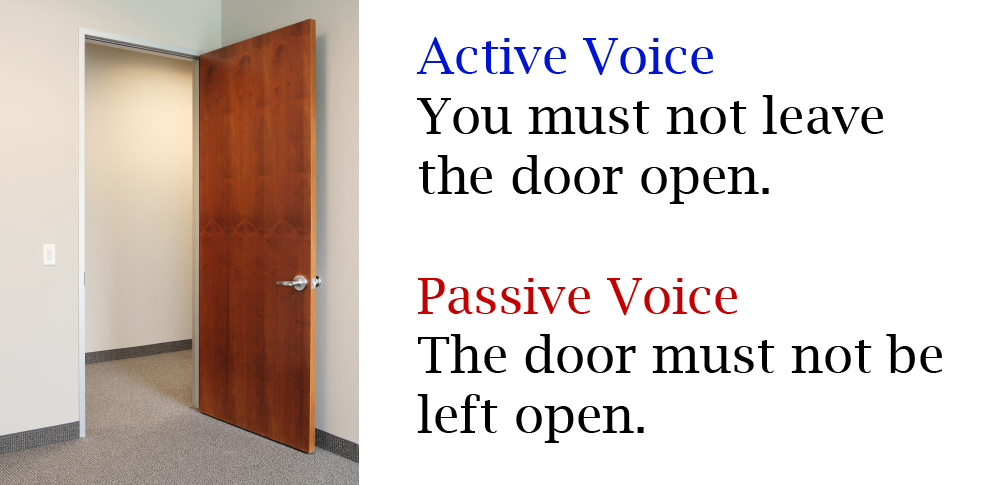How to Use Passive and Active Voice in Business Writing
Passive voice and active voice are two different ways in which a sentence can be structured. Using the wrong type of voice in your marketing or business-related writing can be devastating; the way a sentence is built has a large influence on the reader’s emotional reaction.
There’s a bit of controversy surrounding the concept of passive vs. active voice in copywriting; many advocate avoiding passive voice like the plague. Others point out that passive voice can do certain things that active voice can’t.
To understand the definition of passive and active voice and the difference between them, you should first know how to identify the subject of a sentence. Here’s a brief lesson to help you out.
Finding a sentence’s subject
The definition of a sentence’s subject essentially boils down to “what the sentence is about.” It’s usually the first noun in a sentence, and you can almost always identify it by turning the sentence’s verb into a question.
Take the following two examples.
 Looking at sentence #1, we can ask ourselves, “Who feeds homeless people?” The answer in this case is our charity, so our charity is the subject.
Looking at sentence #1, we can ask ourselves, “Who feeds homeless people?” The answer in this case is our charity, so our charity is the subject.
For sentence #2, we ask, “Who is fed by our charity?” In this instance, homeless people would be the subject.
Even though both sentences effectively describe the same action, sentence #1 is written in active voice and #2 is written in passive voice. So what’s the difference?
Passive voice vs active voice
In passive voice, the subject of a sentence is the “receiver” of an action (or, in certain cases, specifically not receiving an action). So if the sentence is “The door must not be left open,” it’s passive voice because the subject (the door) is not being left open.
Conversely, active voice has the subject “performing” the action. In the case of our previous example, this could convert to something as simple as “You must not leave the door open.” The subject (you) is the one performing the action (not leaving the door open). In general, active voice is preferable to passive voice.

Why should you use active voice?
Passive voice sentences are not technically incorrect, but it’s advisable that you use active voice in your copywriting because it’s direct, concise and authoritative. It’s more natural sounding than passive voice, which has a tendency to sound pretentious and convoluted.
Think of this way: active voice, appropriate enough, is all about action. It gives your product or service a sense of immediacy, and usually does so with fewer words. It’s typically the best option for business copywriting, whether you’re creating headings, subheadings, or body content.
Consider the following two examples:

Option #2 flows a bit better and sounds more natural because it’s written in active voice. It also leads with the fact that the product is recommended by doctors, which is much more interesting to the reader than the name of the product or business.
Additionally, active voice is easier to understand. According to a recent study at Northumbria University, people with less education are less likely to comprehend sentences in passive voice. The same is true for non-native English speakers, though in some countries (like Japan and China), the use of active voice is sometimes considered condescending.
Should you ever use passive voice?
A number of copywriters will decry any use of passive voice, but there are some situations where it can actually be preferable and work to your advantage.
Passive voice is helpful when you want to draw attention away from the person performing the action. Perhaps the “performer” just isn’t very relevant to your concept; it might even be a sensitive or delicate subject. Using passive voice is particularly advantageous for documents where you want to sound objective, such as a legal brief or list of regulations.
Take our earlier example about leaving the door open. “You must not leave the door open” is certainly clear and direct, but it also sounds a bit accusatory and confrontational. “The door must not be left open” might be a better choice. Similarly, “We will not include batteries” implies a fault or failure on the part of the speaker. It almost sounds menacing: we, the company, are willfully denying you batteries. In this case, a more neutral (and preferable) option would be the passive voice phrasing, “Batteries are not included.”
In other cases, you might want to draw extra attention to a subject that is having an action performed upon it. In the active voice sentence “We will give away over 500 prizes,” the most intriguing part of the sentence (the 500 prizes) doesn’t come up until the very end. Meanwhile, “Over 500 prizes will be given away” is written in passive voice, but it leads with the most important info.
Conclusion
Using passive voice and active voice appropriately is vital for writing effectively about your business or concept. As a general rule, think of active voice as your “default setting,” but don’t discount the benefits of passive voice when the situation calls for it.
Posted in Copywriting
Don`t neglect your friends, share this right away.





this is simply wowwww…. 🙂 thnx alot 🙂
Beginning to learn how to become an effective copywriter, this just blows my mind. I am very grateful and I am pursuing more info on this subject. Seems to me like passive and active both have a place on stage. Just need to learn which to use when and where.
Using Grammarly assists writers to identify passive voice. Choosing to make changes remains the decision of the writer.